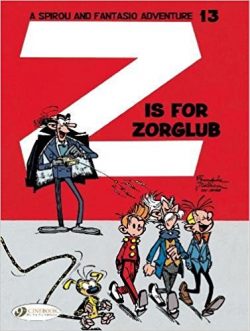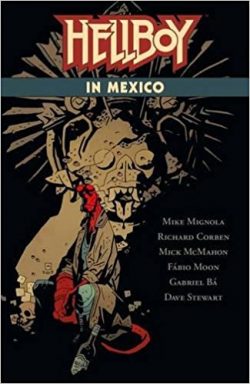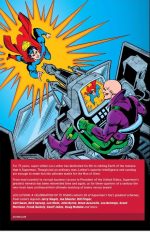
By André Franquin, with Jidéhem & Greg, translated by Jerome Saincantin (Cinebook)
ISBN: 978-1-84918-362-8
Win’s Christmas Gift Recommendation: Masterful Madcap Mirth and Melodrama… 9/10
Spirou (which translates as both “squirrel†and “mischievous†in the Walloon language) was created by French cartoonist François Robert Velter using his pen-name Rob-Vel for Belgian publisher Éditions Dupuis in direct response to the phenomenal success of Hergé’s Tintin over at rival outfit Casterman.
Soon-to-be legendary weekly comic Spirou launched on April 21st 1938 with a rival red-headed lad as lead feature in an anthology which bears his name to this day.
The eponymous young hero was originally a plucky bellboy/lift operator employed in the Moustique Hotel – a sly reference to the publisher’s premier periodical Le Moustique – whose improbable adventures with pet squirrel Spip gradually evolved into high-flying, far-reaching and surreal comedy dramas.
Spirou and his chums have spearheaded the magazine for most of its life, with a phalanx of truly impressive creators carrying on Velter’s work, beginning with his wife Blanche “Davine†Dumoulin who took over the strip when her husband enlisted in 1939. She was assisted by Belgian artist Luc Lafnet until 1943 when Dupuis purchased all rights to the property, after which comic-strip prodigy Joseph Gillain (“Jijéâ€) took the helm.
In 1946 Jijé’s assistant André Franquin assumed the creative reins, gradually ditching the well-seasoned short gag vignettes in favour of epic adventure serials. He also expanded the cast, introducing a broad band of engaging regulars and eventually creating phenomenally popular magic animal Marsupilami to the mix.
First seen in Spirou et les héritiers in 1952, the elastic-tailed anthropoid eventually spun-off into his own strip series; becoming also a star of screen, plush-toy store, console games and albums. Franquin continued concocting increasingly fantastic tales and spellbinding Spirou sagas until his resignation in 1969.
He was followed by Jean-Claude Fournier who updated the feature over the course of nine stirring adventures which tapped into the rebellious, relevant zeitgeist of the times: offering tales of environmental concern, nuclear energy, drug cartels and repressive regimes.
By the 1980s the series seemed outdated and without direction: three different creative teams alternated on the feature, until it was overhauled and revitalised by Philippe Vandevelde (writing as Tome) and artist Jean-Richard Geurts AKA Janry, who adapted, referenced and in many ways returned to the beloved Franquin era.
Their sterling efforts revived the floundering feature’s fortunes and resulted in fourteen wonderful albums between 1984 and 1998. As the strip diversified into parallel strands (Spirou’s Childhood/Little Spirou and guest-creator specials A Spirou Story By…) the team on the core feature were succeeded by Jean-David Morvan & José-Luis Munuera. In 2010 Yoann & Vehlmann took over the never-ending procession of amazing adventures…
Cinebook have been publishing Spirou & Fantasio’s exploits since 2009, alternating between Tome & Janry’s superb reinterpretations of Franquin and earlier efforts from the great man himself.
André Franquin was born in Etterbeek, Belgium on January 3rd 1924. Drawing from an early age, he only began formal art training at École Saint-Luc in 1943. When war forced the school’s closure a year later, he found work at Compagnie Belge d’Animation in Brussels. There he met Maurice de Bévère (Lucky Luke creator “Morrisâ€), Pierre Culliford (Peyo, creator of The Smurfs) and Eddy Paape (Valhardi, Luc Orient).
In 1945 – with the exception of Peyo – they all signed on with Dupuis and Franquin began a career as a jobbing cartoonist and illustrator; producing covers for Le Moustique and Scouting magazine Plein Jeu.
In those early days Franquin and Morris were tutored by Jijé – the chief illustrator at Spirou. He turned the youngsters and fellow neophyte Willy Maltaite AKA Will (Tif et Tondu, Isabelle, Le jardin des désirs) into a smooth creative bullpen known as La bande des quatre or “Gang of Fourâ€.
They later reshaped and revolutionised Belgian comics with their prolific and engaging “Marcinelle school†style of graphic storytelling…
Jijé handed Franquin all responsibilities for the flagship strip part-way through Spirou et la maison préfabriquée, (Spirou #427, June 20th 1946). The new guy ran with it for two decades; enlarging the scope and horizons until it became purely his own. Almost every week fans would meet startling new characters such as staunch comrade and rival Fantasio or crackpot inventor and Merlin of mushroom mechanics the Count of Champignac…
Spirou and Fantasio became globe-trotting journalists, travelling to dangerously exotic places, uncovering crimes, exploring the fantastic and clashing with a coterie of exotic arch-enemies such as Fantasio’s rascally cousin Zantafio and the star of this particular tale, the maddest of scientists Zorglub.
In a splendid example of good practise, Franquin mentored his own band of apprentice cartoonists during the 1950s. These included Jean Roba (La Ribambelle, Boule et Bill), Jidéhem (Sophie, Starter, Gaston Lagaffe) and Greg (Bruno Brazil, Bernard Prince, Achille Talon, Zig et Puce), who all worked with him on Spirou et Fantasio over the years.
In 1955 contractual conflicts with Dupuis droved Franquin to sign up with rival outfit Casterman for Tintin magazine. Here he collaborated with René Goscinny and old pal Peyo whilst creating the raucous gag strip Modeste et Pompon.
Although Franquin soon patched things up with Dupuis and returned to Spirou – subsequently co-creating Gaston Lagaffe in 1957 (and Cinebook’s latest translated comedy star under the oddly inelegant title of Gomer Goof – and coming soon to a review near you!) Franquin was now contractually obliged to carry on his Tintin work too…
From 1959 on, co-writer Greg and background artist Jidéhem increasingly assisted Franquin but by 1969 the artist had reached his limit and resigned.
His later creations include fantasy series Isabelle, illustration sequence Monsters and bleak adult conceptual series Id̩es Noires, but his greatest creation Рand one he retained all rights to upon his departure Рis Marsupilami.
Plagued in later life by bouts of depression, Franquin passed away on January 5th 1997. His legacy remains; a vast body of work which reshaped the landscape of European comics.
Z comme Zorglub was originally serialised in Spirou #1096-1136 between 1959-1960 before being released on the continent in 1961 as the 15th hardcover album.
This outrageous Bond Movie-flavoured sci fi rollercoaster ride begins as an oddly oblivious but extremely sturdy gentleman determinedly delivers a package to the home of our heroes. It looks like a hairdryer, but when vainglorious Fantasio tries it on his own unruly locks, the device plunges him into a coma.
In a panic, Spirou dashes for help and misses the next stage: a mind-controlled Fantasio leaving the house and getting into a remote-controlled car…
It isn’t very well remote-controlled however, and after a calamitous chase through the city crashes into a shop. A little later, baffled, angry and with a badly mangled foot, Fantasio angrily discharges himself from hospital, swearing vengeance on he knows not whom, but the hidden mastermind has not yet finished with the dauntless duo…
Spirou is the next and more successful victim of the mind-warping mystery villain, and the plan quickly becomes clearer: the evil predator is called Zorglub and he doesn’t care about the journalists. He’s simply using the adventurers to get at their inspirational acquaintance: mushroom-mad boffin Count Champignac…
When informed of the situation the sagacious tinkerer is not surprised, he remembers what Zorglub was like when they were at school together…
The enormity of the plot soon becomes clear when megalomaniacal Zorglub confronts his old chum at his mushroom-laden chateau in the generally placid hamlet of Champignac-in-the-Sticks. The wicked mastermind has conceived a grand plan. He will conquer Earth and dominate the solar system but first he requires just a little technical assistance from the Count.
Zorglub cannot believe or accept Champignac’s unflinching refusal…
And thus begins an escalating duel of intellects and war of nerves and inventions as the smug madman tries ploy after ploy to force the Count’s compliance: capturing Fantasio, turning the Champignac-in-the-Sticks citizens into a rampaging mob hungry for blood and even creating an army of mind-warped “zorglmen†to pilot his incredible war machines against the Count and his doughty defenders…
The maniac is, however, caught completely off guard when Spirou, Spip and the Marsupilami enact a bold and rather rash counter offensive with Champignac, just as Zorglub triggers his grand plan and sends his fleet of rockets hurtling towards the Moon!
The end is a sudden, shocking, twist-laden comeuppance but the good guys have not seen the last of Zorglub…
Fast-paced, compellingly convoluted and perfectly blending helter-skelter excitement with keen suspense and outrageous slapstick humour, Z if for Zorglub is a terrific romp to delight devotees of easy-going adventure.
Stuffed with an astounding array of astonishing hi-tech spoofery, riotous chases and gazillions of sight gags and verbal ripostes, this exultant escapade is a fabulous fiesta of angst-free action and thrills. Readily accessible to readers of all ages and drawn with beguiling style and seductive élan, this is pure cartoon gold, truly deserving of reaching the widest audience possible.
Buy it for you, get another for the kids and give copies to all your friends…
Original edition © Dupuis, 1961 by Franquin, Jidéhem & Greg. All rights reserved. English translation 2016 © Cinebook Ltd.











